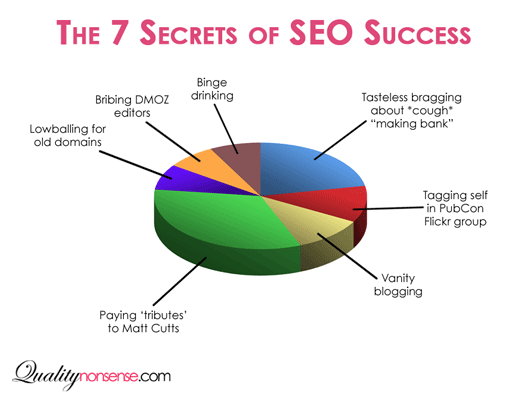Your posts are very informative. You ask a lot of good questions, but don't seem to have the answers. - preferred to remain anonymousLooking over my last few posts, there's something to the critique.
In my own defense, I've got to say I think asking the right questions is the best way to find the answers. That may sound like running to the high ground to some. That is how I think though. Despite training and experience as an analyst in technical work, I've learned my mind is geared right-brain. I'm an intuitive thinker. My Kiersey surveys confirm it.
Some of the questions I've asked were more to point out issues to be aware of, to see how they work out. For example, how Universal Search will affect SERPs and useability issues is open to conjecture at this point. We're just going to have to wait and see.
Many times, answers to questions would only be anecdotal. A case study might help clarify some issues, but realistically every website and business has different goals and requirements. The answers depend upon many issues like:
- The integration of the website in the business process;
- Is the company or website established itself on the Web?;
- The technical skills of the owner?;
- Is the website ready to be marketed?;
- What sort of marketing will be efficient within the advertising budget?;
- and many others both more general and more specific.
Her critique is valid. It calls into question my problem-solving abilities; and my presentation of the company on this blog.
She wants to see definitive answers. That's a valid concern for prospective customers, and has come to be expected by consumers from those who purport to be gurus or experts.
Problem solving
Because I'm usually involved in technical problems where the customer doesn't know the terminology much less understand the concepts involved, I've use established methods to document my problem solving efforts.
For clarification of an issue, I'll use Is-Is Not lists. To illustrate the process, I'll use the 5 Why's system. Both methods are easy to understand and intuitive.
In Project Management, the 5 Why's method organizes and documents brainstorming sessions. In marketing, it allows my Customers to think like their Customers - Consumers.
Asked why Consumers should use their products or services, a Customer will go into some depth about the quality of their products and their qualifications to provide their services - but that is rarely why Consumers buy. Consumers buy because their products and services meet a Consumer need or want. Asking 5 Why's usually elicits much more marketable terms and scenarios.
The best part of using these methods is they present topics which can be questioned.
At best, the results build Customer confidence. The give and take of questions becomes a team building exercise. The Customer becomes actively involved in the planning and process. Synergy builds. After all, my Customer is the expert in their field. I'm listening to the best expertise available: my Customer.
Synergy doesn't always happen. But it is always worth a shot.
Conflicting Styles
Because of the wide range of technical expertise in my Customers, I've developed two conflicting styles to present my SEO/SEM efforts.
One, is to just present my conclusions and state the steps necessary to solve the problem. Essentially: Just do it.
Personally, I'm uncomfortable with this style, but it is the only thing that can be done when the Customer's attitude or circumstances demand it. This approach is always problematical.
Marketing a website is not an exact science. It's a process. And involves a little luck.
Luck in this case is defined as where Opportunity meets Preparation. All I can really do is make the site as ready for the Web as possible; which includes offsite marketing as well as page design and content.
For Customers who demand to know exactly when it will all happen, the process is frustrating. The best I can do is present the efforts of me and my team in steps, and emphasize the achievements as they happen.
My preferred approach is to involve the site owner, either directly or through the assigned liason person(s), in the process. I prefer a dialogue between myself and my Customers. This empowers my customers as they learn. It's not possible to discuss everything in depth. I tend to emphasize the steps that the customer can see, just as for those who want a 'Just do it' style.
I've gotten two critiques of this style:
1) All you're doing is teaching your Customers what they need to stop employing you. - A very Australian perspective.;
and 2) You talk (or explain) too much. I tend to write long emails explaining issues and tying many concepts together. If someone wants to know what I'm doing and why, I'll take the time to tell them. I prefer educated Customers.
My preferred style comes from California. It has proven problematical in Australia, especially with small business owners.
This blog is my way of getting my thoughts out. It probably spares my Customers a lot of eye strain.
Do I have all the answers? No. Anyone who pretends to have all the answers is like SEO companies that offer guarantees - best to be avoided.
I'm not going to pretend to be omniscient or clairvoyant. The Web changes constantly. The best anyone can do is try to keep up. That's what keeps the work fascinating and challenging.
Can I support my conclusions? Yes, usually in some depth. In most cases, I can even document my thinking. Some issues are easy: Every site needs SEO. Other issues are open to experiment and conjecture: Is it better to have wide registration or PPC? The answer depends on the company's market position, long-term and short-term goals.
I wonder if I've answered my critical friend.
SEO/SEM in Australia is a special issue for so many reasons. Join me was we explore. It will be a fascinating and informative journey. Sphere: Related Content















